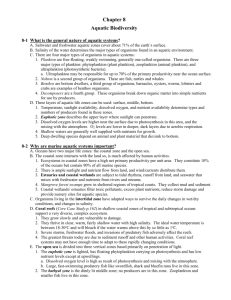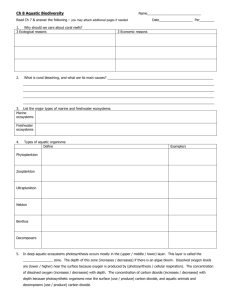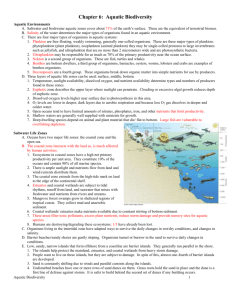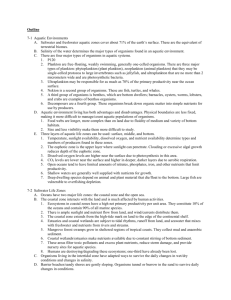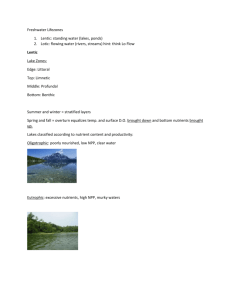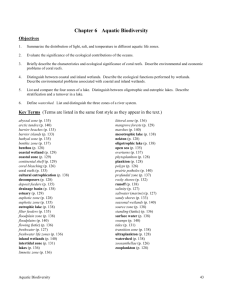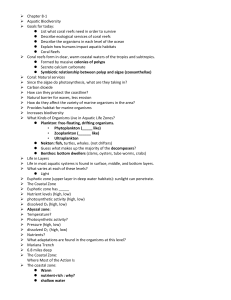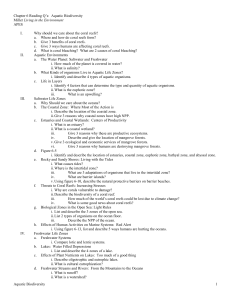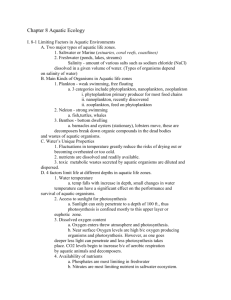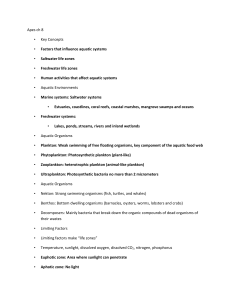Chapter6 - mariaoconnell
advertisement
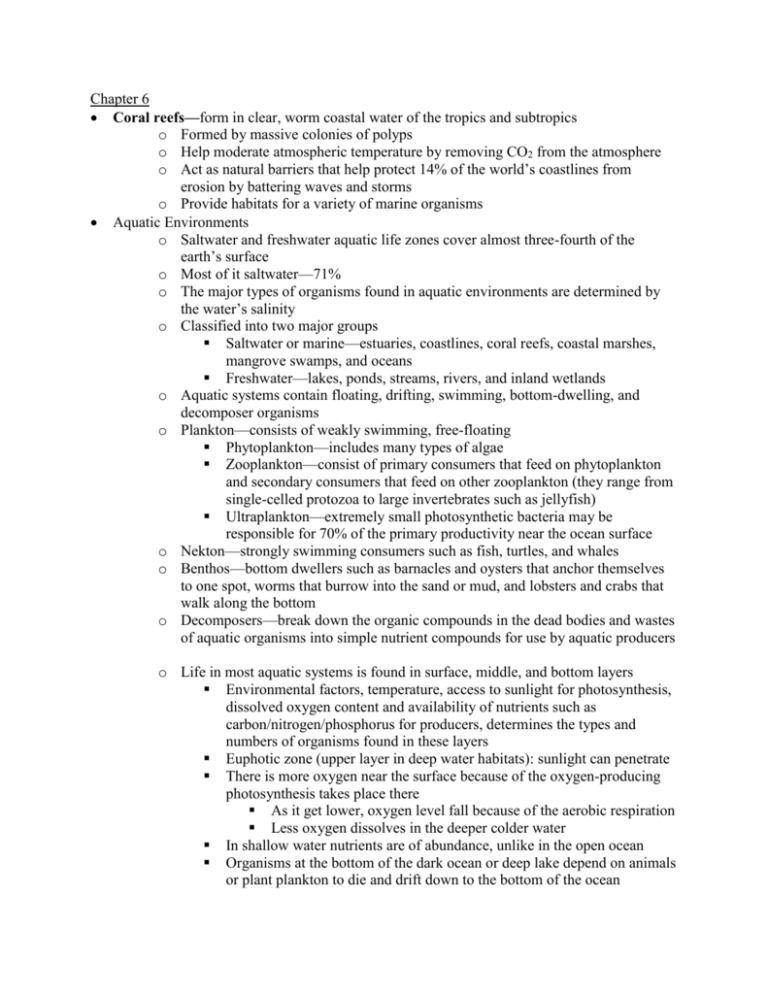
Chapter 6 Coral reefs—form in clear, worm coastal water of the tropics and subtropics o Formed by massive colonies of polyps o Help moderate atmospheric temperature by removing CO2 from the atmosphere o Act as natural barriers that help protect 14% of the world’s coastlines from erosion by battering waves and storms o Provide habitats for a variety of marine organisms Aquatic Environments o Saltwater and freshwater aquatic life zones cover almost three-fourth of the earth’s surface o Most of it saltwater—71% o The major types of organisms found in aquatic environments are determined by the water’s salinity o Classified into two major groups Saltwater or marine—estuaries, coastlines, coral reefs, coastal marshes, mangrove swamps, and oceans Freshwater—lakes, ponds, streams, rivers, and inland wetlands o Aquatic systems contain floating, drifting, swimming, bottom-dwelling, and decomposer organisms o Plankton—consists of weakly swimming, free-floating Phytoplankton—includes many types of algae Zooplankton—consist of primary consumers that feed on phytoplankton and secondary consumers that feed on other zooplankton (they range from single-celled protozoa to large invertebrates such as jellyfish) Ultraplankton—extremely small photosynthetic bacteria may be responsible for 70% of the primary productivity near the ocean surface o Nekton—strongly swimming consumers such as fish, turtles, and whales o Benthos—bottom dwellers such as barnacles and oysters that anchor themselves to one spot, worms that burrow into the sand or mud, and lobsters and crabs that walk along the bottom o Decomposers—break down the organic compounds in the dead bodies and wastes of aquatic organisms into simple nutrient compounds for use by aquatic producers o Life in most aquatic systems is found in surface, middle, and bottom layers Environmental factors, temperature, access to sunlight for photosynthesis, dissolved oxygen content and availability of nutrients such as carbon/nitrogen/phosphorus for producers, determines the types and numbers of organisms found in these layers Euphotic zone (upper layer in deep water habitats): sunlight can penetrate There is more oxygen near the surface because of the oxygen-producing photosynthesis takes place there As it get lower, oxygen level fall because of the aerobic respiration Less oxygen dissolves in the deeper colder water In shallow water nutrients are of abundance, unlike in the open ocean Organisms at the bottom of the dark ocean or deep lake depend on animals or plant plankton to die and drift down to the bottom of the ocean These organisms take long to reproduce, so they are especially vulnerable to depletion from overfishing Saltwater Life Zones o Coastal Zone: Most of the Action is Makes up less than 10%, but contains 90% of all marine species Warm, nutrient-rich, shallow water that extends from the high-tide mark on land to the gently sloping, shallow edge of the continental shelf Human activities severely affect it Have high net primary productivity, thanks to the zones ample sunlight and plant nutrients that flow from land are distributed by tidal flows and ocean currents o Estuaries and Coastal Wetlands: Center of Productivity Highly productive ecosystems Estuary—where river meats sea (fresh and saltwater) Runoff and pollution from the streams mix in as well Coastal wetlands—land areas covered with water all or part of the year River mouths, inlets, bays, sounds, salt marshes in temperate zones and mangroves in tropical ones Life here adapts to daily and seasonal changes in tidal and river flow and land runoff of eroded soil sediment and other pollutants Rapid circulation of nutrients by tidal flows Mangrove forests—the tropical equivalent of salt marshes These trees can grow in salt water and have extensive roots that often extend above the water, where they get oxygen and help the plant with changing water levels Estuaries and coastal marshes provide ecological and economic services. Filter toxic pollutants, excess plant nutrients, sediments, and other pollutants. Reduce storm damage by absorbing waves and storing excess water produced by storms and tsunamis. Provide food, habitats and nursery sites for many aquatic species Rocky and Sandy Shores: Living with the Tides o Organisms have survived to the harsh and changing conditions of this area o Gravitational pull by moon and sun causes tides. o Intertidal Zone: area of shoreline between low and high tides. o The organisms must be able to adapt to the changing salinity Most of them hold onto something, dig in, or hide in protective shells o Barrier Islands: Low, narrow, sandy islands that form offshore from a coastline Primary and secondary dunes on gently sloping sandy barrier beaches protect land from erosion by the sea Threats to coral reefs: Increasing Stress o Biologically diverse and productive coral reefs are being stressed by human activities. o Coral reefs can only live between 18-30 oC – a change in one degree could cause bleaching Also people touching and breaking parts of can cause bleeching Biological Zones in the Open Sea: Light Rules o Brightly light surface, dimly lit middle, and dark bottom zone o Euphotic zone: brightly lit surface layer. Nutrient levels low dissolved O2 high, photosynthetic activity. o Bathyal zone: dimly lit middle layer. No photosynthetic activity, zooplankton and fish live there and migrate to euphotic zone to feed at night. o Abyssal zone: dark bottom layer. Very cold, little dissolved O2 The animals get their nutrients from marine snow—a shower of dead or decaying organisms Effects of Human Activities on Marine Systems: Red Alert o Human activities are destroying or degrading many ecological and economic services provided by the world’s coastal areas. Freshwater Life Zones Freshwater System o Freshwater life zones include: Standing (lentic) water such as lakes, ponds, and inland wetlands. Flowing (lotic) systems such as streams and rivers Lakes: Water-Filled Depressions o Littoral Zone: Top of the water o Limnetic Zone: the main part of the water, first layer into the water o Profundal zone: Below limnetic zone, no photosynthesis, animals have adapted to the colder water o Benthic Zone: filled with decomposers and is filled with nutrients from the dead/decaying fish o During summer and winter in deep temperate zone lakes become stratified into temperature layers and will overturn. This equalizes the temperature at all depths. Oxygen is brought from the surface to the lake bottom and nutrients from the bottom are brought to the top Effects of Plant Nutrients on Lakes: Too Much of a Good Thing o Plant nutrients from a lake’s environment affect the types and numbers of organisms it can support o Oligotrophic lake: poorly nourished, usually newly formed lake with small supply of plant nutrient input. o Eutrophic lake: well nourished, over time, sediment, organic material, and inorganic nutrients wash into lakes causing excessive plant growth. Cultural eutrophication: Human inputs of nutrients from the atmosphere and urban and agricultural areas can accelerate the eutrophication process o Mesotrophic lake: in between Freshwater Streams and Rivers: From the Mountains to the Oceans o Water flowing from mountains to the sea creates different aquatic conditions and habitats o Surface water—precipitation that does not sink into the ground or evaporate o Runoff—surface water that flows into streams o Watershed/drainage basin—is the land area that delivers runoff, sediment, dissolved substances to the stream o Three zones: Source zone Rapids, high in the mountains, dissolve a lot of oxygen from the air Cold, clear, swift Fish that live there are adapted to the cold and they must be able to swim in the currents , have flat bodies to fit under stones Mosses and algae attach to rocks Transition zone Streams merge together, slower and more cloudy Less dissolved oxygen Warmer and less oxygen Floodplain zone High temperatures and less dissolved oxygen than the other two zones Slow-moving rivers Because of the runoff, the water is muddy and contains high concentrations of suspended particulate matter (silt) Eventually hits the sea Dams and levees have been built to control water flows in New Orleans. Reduction in natural flow has destroyed natural wetlands. o Causes city to lie below sea-level (up to 3 meters). o Global sea levels have risen almost 0.3 meters since 1900 Freshwater Inland Wetlands: Vital Sponges o Inland wetlands act like natural sponges that absorb and store excess water from storms and provide a variety of wildlife habitats. o Filter and degrade pollutants. o Reduce flooding and erosion by absorbing slowly releasing overflows. o Help replenish stream flows during dry periods. o Help recharge ground aquifers. o Provide economic resources and recreation o

